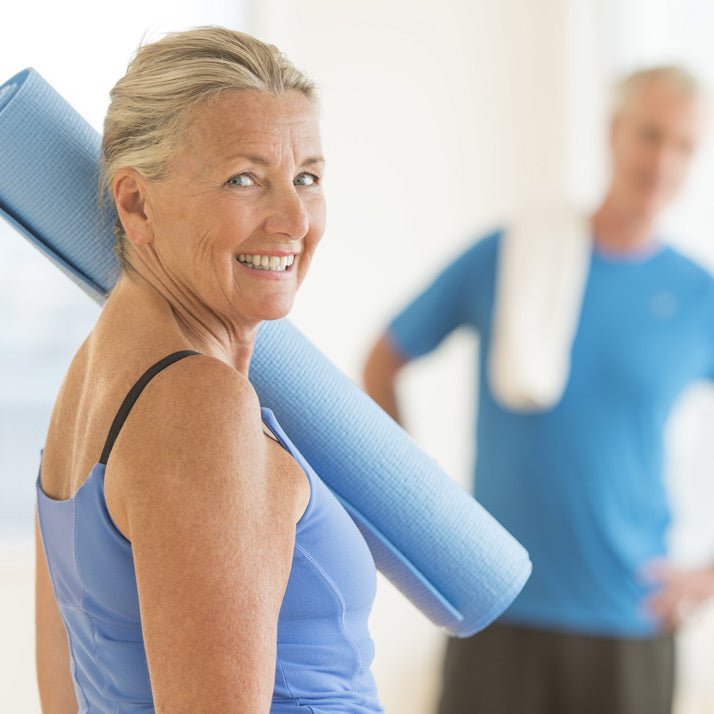Fitness Past 50: Exercises You Should Be Doing to Stay Strong and Healthy
4 minute read
As we age, we start becoming a little more concerned and conscious about our health. This is particularly true when they hit that half-century milestone of turning fifty, and it only escalates after that. Suddenly, it becomes crystal clear that exercise is no longer just an option, but a necessity. However, exercises aren't only necessary for heart health. It's also important for all seniors to implement an exercise routine that include both strengthening and balances exercises as well.
What Types of Exercises Are Most Important for Seniors?
Seniors can benefit from a variety of different types of exercises. The type of routine you implement should correlate with your age and mobility. Since joints don't have the same kind of buffer and lubrication as they once did, and because tendons and ligaments may have weakened over time, most doctors recommend a combination of low impact workouts for cardiovascular health, as well as strength and balances exercises.
Walking, using a treadmill (but not running on it), swimming, taking a dance class, elliptical motion machines, kayaking, using a rowing machine, stair climbing and biking - these are all low impact workouts that improve vascular and heart health, as well as gently strengthening muscles. Simply engaging in low-impact activities, however, is not enough.
According to the Centers for Disease Control and Prevention, strength training can help reduce the signs and symptoms of chronic conditions and a number of diseases, including osteoporosis, arthritis, back pain, depression, obesity, and diabetes. Still, some seniors do not participate in strength training because they believe they cannot perform the exercises, but this just isn't true. Chair exercises for seniors can not only help build strength, but can provide cardiovascular benefits as well.
Chair exercises for seniors are designed for those who don't have great mobility, but who still need to improve strength, internal health and circulation. Even for those seniors who are still able to walk very well, they may want to begin with chair exercises in order to improve strength first, before working on balance. The University of Georgia recommends the following chair exercises for seniors, as collected from the National Osteoporosis Foundation, the National Institutes of Health, Lifetime Fitness Program in Seattle, WA, and Exercise, Etc.:
Seated
- Head and Shoulder Rolls
- Side Bends
- Calf and Hamstring Stretches
- Foot Flexes
- Bicep Curls (with light weights)
- Shoulder Flexion (with light weights)
- Tricep Extensions (with light weights)
- Side Arm Lifts (with light weights)
Standing, or Behind Chair (Using Chair for Balance)
- Chair Stand (stand up from seated position, then sit down; similar to a squat)
- Toe Taps (from behind the chair, holding onto back)
- Alternating Knee Raises/Knee Flexion (from behind the chair, holding onto back)
- Side Leg Raise
Aside from these chair exercises, there are also machines at the gym that can really get your blood pumping from a seated position. Among these are the arm bicycle, rowing machines, lat pull-down machines, and other various upper and lower body devices. Light weights are in order here, however, as it's easy for seniors to overdo it.
In addition to seated exercises, what many seniors overlook are balance exercises. Balance exercises for seniors are especially important, because a majority of injuries in older individuals come from falling accidents.
Balance exercises for seniors may include full exercise regimens like Pilates or Tai Chi, but may also be as simple as a few exercises you do on your own. The National Institute of Health (NIH) recommends the following five exercises as a means of improving balance in seniors:
- Standing on one foot
- Walking heel to toe
- Balance walk
- Back leg raises
- Side leg raises
How Often Should Seniors Work Out?
Currently the widely held standard for the amount of time seniors should be working out equates to 150 minutes of moderate aerobic activity per week. This comes from the published guidelines in The American College of Sports Medicine and American Heart Association. They also recommend resistance (strength training, like weights and calisthenics), flexibility, and balance exercises too, with resistance and flexibility activities being performed twice per week. However, when it comes to balances exercises, since they are not overworking muscles that need time for repair, they may be performed repeatedly and on a daily basis.
Seniors need exercise for a variety of reasons and if you are over fifty, you should be exercising regularly no matter how mobile or strong you are to start. You may live a lot longer than you think, and you will want to look and feel good for the rest of your life.












